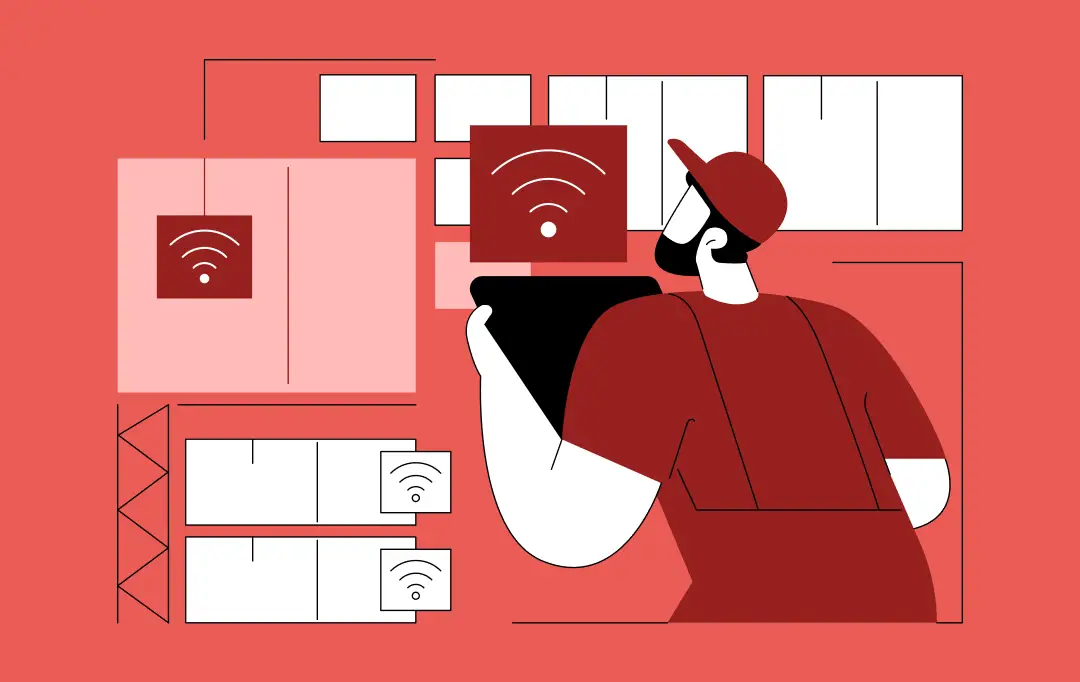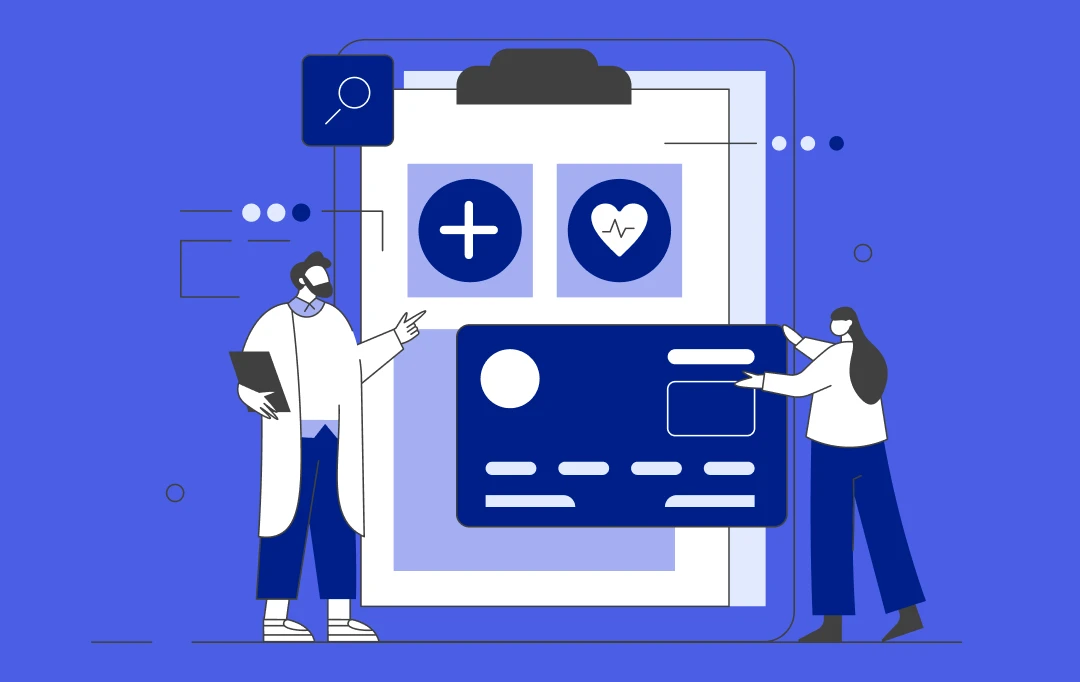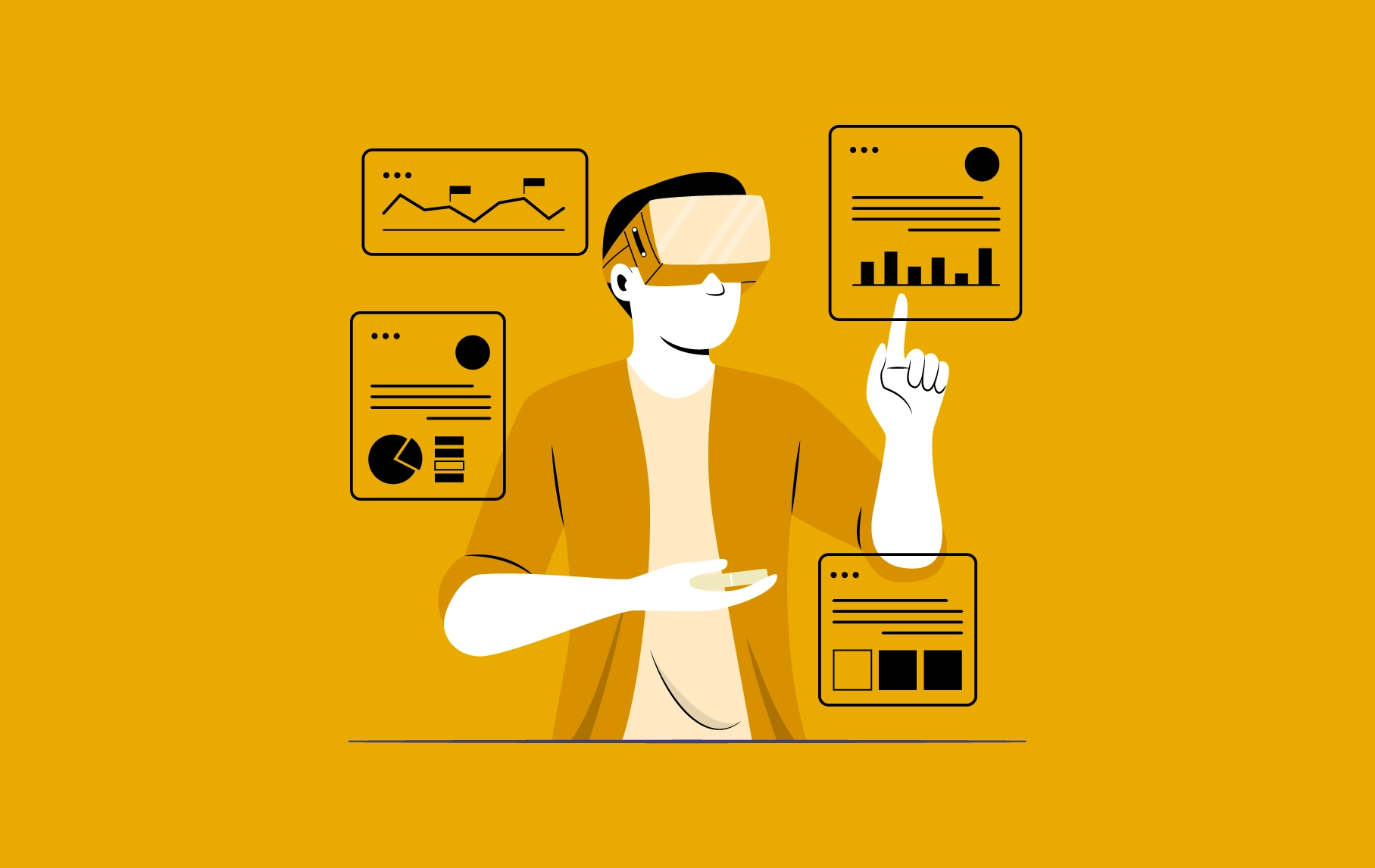- Why Healthcare Needs Conversational AI More Than Ever
- 10 Use Cases of Conversational AI in Healthcare
- 1. Patient Self-Service & Virtual Assistance
- 2. Symptom Checking & Early Triage
- 3. Medication Adherence & Chronic Care Support
- 4. Clinical Documentation Automation
- 5. Insurance & Claims Assistance
- 6. Mental Health & Counseling Support
- 7. Post-Treatment Engagement & Recovery Monitoring
- 8. Clinical Decision Support for Physicians
- 9. Compliance & Risk Management
- 10. Expanding Access in Rural & Underserved Areas
- Benefits of Conversational AI in Healthcare
- How to Make Conversational AI Work Inside Your Hospital’s Existing Tools
- Challenges and Considerations When Implementing Conversational AI in Healthcare
- Data Privacy and Security
- Bias and Safety
- Integration with Existing Systems
- User Adoption and Trust
- Future Outlook: Generative Conversational AI in Healthcare
- What It Will Take to Get There
- How Appinventiv Can Help with Conversational AI in Healthcare
- FAQ’s
Key Takeaways
- Care that feels one step ahead. Conversational AI doesn’t just answer questions — it notices patterns and helps patients before small worries turn into big problems.
- Every patient feels like the only one. Whether it’s language, timing, or tone, these systems adjust to make each interaction feel personal and comforting.
- Doctors get to be doctors again. Instead of typing late into the night, clinicians can focus on people, while AI quietly takes care of the paperwork.
- The small stuff finally runs smooth. Billing, scheduling, follow-ups — the everyday tasks that usually eat time are handled in the background, so nothing slips through.
- Trust becomes the real technology. The hospitals that win aren’t just using AI — they’re showing patients it’s safe, transparent, and built with empathy.
Healthcare is stretched thin right now. Patients expect quicker answers and more convenience, doctors are burning out, and the cost of running hospitals keeps climbing. The industry is under pressure to do more with less, emerging digital tools are now the only way to keep doors open and care reachable.
That’s why conversational AI in Healthcare is starting to matter. We’re not talking about the old, rigid chatbots that gave canned replies. These newer systems can actually understand what people are asking, respond in a natural way, and take on sensitive tasks like triage or follow-ups without losing the human touch.
And the shift is happening fast. A McKinsey report points out that healthcare leaders are now putting serious investment into chatbots, conversational AI, and virtual assistants to stay competitive and meet patient expectations. Meanwhile, Deloitte notes that three out of four leading healthcare organizations are already testing or scaling generative AI use cases.
The signal couldn’t be clearer: conversational AI technology in healthcare has moved past the pilot stage — it’s becoming central to how modern healthcare works.
Build secure, enterprise-grade conversational AI with Appinventiv and move faster from pilot to production
Why Healthcare Needs Conversational AI More Than Ever
Conversational AI technology in healthcare refers to intelligent systems like chatbots, voice assistants, and generative agents that can understand and respond to patients, clinicians, or staff in natural language. With advanced AI powering them, these tools are now capable of nuanced, contextual, and empathetic interactions.
Conversational AI for healthcare: The Urgency Behind Adoption
- Administrative overload: Clinicians spend a lot of time on paperwork and documentation. McKinsey shows conversational AI is being used to automate some of these tasks, so clinicians can spend more time with patients.
- Clinician burnout: The burden of repetitive admin tasks is a leading driver of stress and attrition.
- Patient expectations: Today’s patients demand 24/7, personalized support — from scheduling appointments to post-care follow-ups.
- Cost pressures: Healthcare providers are under pressure to deliver more with fewer resources. Conversational AI provides scalability at lower cost.
Academic evidence also supports this shift. A physician-supervised LLM-based agent trial showed conversational AI can safely handle patient queries while maintaining high satisfaction.
The table below shows the differences between rule-based chatbots and conversational AI in healthcare.
| Feature | Rule-based Chatbots | Conversational AI |
|---|---|---|
| Language Understanding | Keyword triggers only | Contextual NLU |
| Personalization | None | Adjusts tone, timing |
| Clinical Safety | Limited, canned replies | Escalates to human |
| Integration | Usually siloed | API-level connectors |
| Value | Deflects simple queries | 24/7 self-service & admin relief |
10 Use Cases of Conversational AI in Healthcare
Conversational AI is no longer just a buzzword in boardrooms. It’s reshaping patient journeys, giving clinicians time back, and helping hospitals survive relentless cost and staffing pressure. Here’s how it’s working right now — with real brands and measurable results.
1. Patient Self-Service & Virtual Assistance
Healthcare’s digital front door is finally getting smarter. Instead of calling and waiting on hold or filling long web forms, patients can now interact with conversational AI naturally to ask questions, get directions, and even book appointments in a chat-like flow. It feels intuitive and immediate, reducing friction from the first contact.
Real example: Intermountain Health & Hyro
Intermountain Health deployed Hyro to answer FAQs, guide patients to the right department, and schedule appointments. The AI lives on web, mobile, and voice channels, so patients can text or call any time and still get quick help. Hyro’s data shows the assistant resolved 79% of incoming chats without hand-off to staff, saving thousands of calls a month and reducing patient wait frustration.
Why it works: The system links directly to Intermountain’s scheduling and wayfinding data. Patients aren’t sent to dead ends, they can pick time slots, confirm details, and even get follow-up reminders.
2. Symptom Checking & Early Triage
When symptoms show up after late hours, panic often leads to unnecessary ER trips. Conversational AI gives patients a safe first step with structured, clinically backed questions and guidance on what to do next. It is fast, reassuring, and designed to escalate when needed.
Real example: Mayo Clinic’s AI-Powered Nurse Virtual Assistant
Mayo Clinic launched an AI-powered Nurse Virtual Assistant that integrates with its electronic health record (EHR) to give nurses instant access to patient summaries, IV guidelines, and clinical policies. Built with frontline nurse input and approved by Mayo’s Institutional Review Board, it now supports 9,600+ nurses across inpatient and emergency care, reducing admin work so they can focus more on patients while ensuring HIPAA compliance.
Why it works: Clinician oversight shaped every question path, and the system clearly states when escalation to a human is needed. That mix of automation and safety keeps trust high.
3. Medication Adherence & Chronic Care Support
Managing a long-term condition is exhausting and forgetting medication can have big consequences. AI-driven check-ins and reminders make staying on track easier by blending medical data with gentle nudges so patients feel supported, not overwhelmed.
Real example: Mount Sinai Health System & HealthSnap
Mount Sinai Medical Center partnered with HealthSnap to roll out Remote Patient Monitoring (RPM) and Chronic Care Management (CCM) programs for patients with diabetes, hypertension, heart failure, COPD, and other long-term conditions. The platform integrates with Mount Sinai’s Epic EHR, capturing real-time patient data such as vitals, activity, and medication patterns. This allows care teams to spot early warning signs, send timely nudges, and intervene before complications escalate.
Why it works: Continuous monitoring and AI-driven alerts adapt to each patient’s engagement and risk level. Data flows directly into clinical systems so providers can step in when needed — turning reactive care into proactive support.
4. Clinical Documentation Automation
Doctors spend hours each day typing notes. Conversational AI quietly takes over that burden as it listens during consultations and drafts structured documentation, cutting hours of admin. That means physicians can look up and talk to their patients more instead of staring at a screen.
Real example: Microsoft Nuance Dragon Ambient eXperience (DAX)
Nuance DAX listens during patient encounters and turns conversations into structured notes for the EHR. WellSpan Health rolled it out across specialties and reported an average of seven minutes saved per visit. Some physicians reclaimed two extra hours a day, time they used to catch up on patient calls or finish on time.
Why it works: Doctors can see and edit every note before signing off. That transparency builds confidence and keeps legal risk low.
Healthcare providers are implementing speech recognition software that automates clinical documentation, enabling physicians to dictate patient encounters hands-free and reducing the time spent on administrative paperwork by more than 50%.
5. Insurance & Claims Assistance
Insurance should not feel like solving a puzzle. Conversational AI steps in to simplify coverage questions, eligibility checks, and claims filing. Patients get clearer answers and hospitals move paperwork faster while avoiding call center overload.
Real example: Helvetia Insurance
Helvetia built a Facebook Messenger claims bot that authenticates users, gathers details, and advances the claim. Customers upload photos, describe the issue, and track progress instantly. This cut claim processing time from days to minutes and reduced inbound support calls.
Why it works: The bot connects directly to Helvetia’s policy database and back-end workflow, so responses are accurate and personalized — not generic FAQ scripts.
6. Mental Health & Counseling Support
Opening up about mental health is not easy. Stigma and long wait times make it worse. Conversational AI creates a private, judgment-free first step while guiding users toward professional care when needed. It helps people feel heard and supported right away.
Real example: Woebot Health
Woebot provides always-on cognitive behavioral support through chat. Health systems use it to supplement therapy, offer safe check-ins, and flag urgent risk. In clinical studies, Woebot users saw significant improvement in depressive symptoms within two weeks, and retention was higher than typical digital wellness apps.
Why it works: It’s anonymous and stigma-free. Plus, Woebot hands off to professionals when conversations suggest crisis or complex needs.
7. Post-Treatment Engagement & Recovery Monitoring
Leaving the hospital is just the beginning of recovery, but follow-ups can be confusing and delayed. Conversational AI keeps the connection alive with check-ins, tailored instructions, and early alerts for complications. It gives patients confidence and clinicians visibility.
Real example — Northwell Health & Conversa Health
Northwell Health rolled out a conversational AI solution (Northwell Health Chats, powered by Conversa) to stay connected with patients after procedures and during recovery. It sends prompts like “How’s your pain level today?” and symptom check-ins, triggering clinician alerts when needed. Early deployments showed 97% patient satisfaction and reduced post-acute care costs from fewer avoidable readmissions.
Why it works: Conversations feel timely and personalized, not just generic push alerts. Because responses tie back into Northwell’s care teams, staff can intervene before a small issue becomes serious.
8. Clinical Decision Support for Physicians
Doctors juggle an overwhelming amount of information while making critical decisions. Conversational AI cuts through the noise, surfaces key patient data, and gives real-time answers. It helps clinicians act faster and more confidently without losing control.
Real example — Mayo Clinic Platform & Ambient Intelligence
Mayo Clinic Platform is working on conversational / ambient intelligence tools that allow clinicians to ask questions in natural language (e.g. “Show me this patient’s cardiology notes”) and receive synthesized, context-aware responses. In its “Transformative Power of Conversational Technologies” blog, Mayo describes how ambient clinical intelligence can listen to physician–patient dialogue, translate lay terms into clinical ones, and summarize relevant information.
Why it works: AI doesn’t replace clinician judgment — it surfaces data doctors already trust within familiar workflows. The conversational interface and clear sourcing promote confidence and speed in decision making.
9. Compliance & Risk Management
Healthcare runs on trust, and that trust can be fragile if records are incomplete or compliance slips. Conversational AI helps catch these issues early by scanning data for gaps, standardizing records, and creating clear, audit-ready trails so staff can focus on care instead of compliance anxiety.
Real example — Agentic AI under HIPAA Governance
A recent research work proposes an agentic AI system designed for clinical workflows that enforces HIPAA compliance via attribute-based access control, PHI sanitization, and audit logging. This approach ensures that AI actions remain auditable and regulatory-safe even when the system acts autonomously.
Why it works: By embedding compliance logic, audit trails, and data governance at the AI architecture level, the system mitigates risk before external review, while still supporting human oversight.
10. Expanding Access in Rural & Underserved Areas
For many patients living far from hospitals, timely care is not guaranteed. Conversational AI bridges the distance by offering 24/7 symptom assessment, care navigation, and language support. It is a practical way to bring medical help closer to those who need it most.
Real example — Ada Health & Sutter Health
Sutter Health partnered with Ada Health to integrate Ada’s AI symptom assessment and care navigation tools into Sutter’s systems. Patients complete a symptom check via Ada, get triage advice (e.g. self-care, clinic, telehealth, emergency), and can be directed immediately into Sutter’s care pathways. Over 410,000 assessments have been completed, and about 40% of patients have been navigated to less urgent care settings.
Why it works: Local language support, continuous access, and built-in referral paths mean patients actually use it. Plus, integration with Sutter’s systems ensures the recommended next steps lead into real care—so it’s not just another app.
Explore how Appinventiv’s conversational AI for healthcare services can help you stay ahead.
Benefits of Conversational AI in Healthcare
The examples show where conversational AI for healthcare is being used, but the bigger story is in what all of this adds up to. It’s not just about chatbots or voice assistants doing small tasks — it’s about how conversational AI agents for healthcare are changing the way care feels when these tools are woven into the system. Patients get quicker answers. Doctors get a little breathing room. Hospitals get a way to do more without constantly stretching their people to the limit.
- Humanized Care at Scale
For patients, the benefit is simple: it feels like someone is always there. Whether it’s midnight or early morning, an AI assistant can answer a question, book a slot, or reassure someone who isn’t sure what to do next. That kind of 24/7 presence builds trust in a way static websites never did. - Workforce Relief and Retention
Ask a doctor or nurse why they feel burned out and paperwork almost always comes up. Conversational AI for hospitals can’t remove every form or chart, but it does take a big bite out of the admin load. That means more face-to-face time with patients and a little less stress at the end of a long shift. Over time, that relief matters — it makes the job more sustainable. - System-Wide Efficiency Gains
These tools don’t just help one department. They smooth the edges across the whole system. Scheduling, billing, follow-ups — all the small interactions that often clog up staff time — get faster and cleaner. For hospitals, that means lower costs and fewer errors. For patients, it means fewer delays. - Resilience in Times of Crisis
Anyone who worked in healthcare during COVID-19 knows what it’s like when demand explodes overnight. Conversational AI can’t replace doctors, but it can absorb the wave of questions that overwhelm call centers. Thousands of queries can be handled at once, making the system more resilient when people need it most. - Trust Through Compliance & Accuracy
Healthcare is unforgiving when it comes to mistakes. A missing note, a misplaced detail — it all matters. Conversational AI helps by creating standardized records, making documentation cleaner and audit-ready. That consistency reassures regulators, and more importantly, reassures patients that their information is safe and accurate. - Proven Confidence from Leadership
This isn’t just a tech experiment. Healthcare leaders are already putting weight behind these intelligent tools. A recent survey from Elation Health showed that 66% of primary care physicians believe AI (including conversational AI tools) will significantly improve practice operations and efficiency over the next two years. With this level of confidence, conversational AI is rapidly moving from the sidelines — it’s becoming a core component of healthcare strategy. Elation Health
In short, the benefits of conversational AI in healthcare extend beyond efficiency — and each healthcare conversational AI use case highlights its impact on trust, accessibility, and the overall care experience.
How to Make Conversational AI Work Inside Your Hospital’s Existing Tools
For conversational AI to truly work in healthcare, it can’t sit on the side as a separate chatbot. It has to talk to the same core systems clinicians and patients already rely on, securely and in real time. Here’s how modern healthcare AI makes that happen:
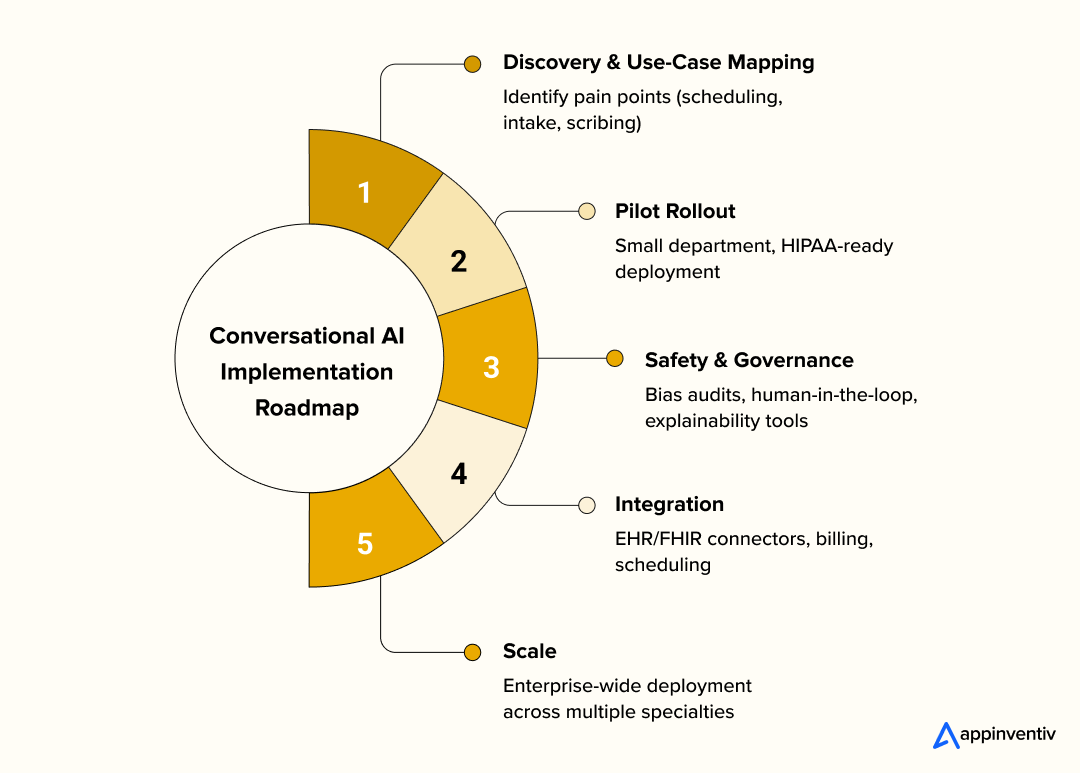
1. Integration Protocols
- HL7 (Health Level Seven): Conversational AI tools use HL7 messaging to exchange structured patient data with electronic health records (EHRs), ensuring smooth interoperability.
- FHIR (Fast Healthcare Interoperability Resources): FHIR lets AI apps securely pull charts, allergies, and vitals or push visit notes back into the record in a standardized format.
- SMART on FHIR: This combination enables healthcare apps to run safely inside EHRs without separate logins, making AI accessible right where clinicians work.
2. API Connectivity
- EHR APIs: Direct connections allow conversational AI to update documentation, surface medication lists, and sync visit notes into existing workflows.
- Scheduling APIs: AI assistants can check calendars, schedule or cancel appointments, send confirmations, and manage follow-ups automatically.
- Diagnostic & Imaging APIs: Some tools can fetch imaging results or lab reports so patients and providers get faster, context-rich answers.
3. Interoperability & Data Standards
- CCDA (Consolidated Clinical Document Architecture): Supports sharing discharge summaries, progress notes, and referrals with AI systems for safe downstream use.
- Claims & Billing Standards: Advanced solutions connect with clearinghouses and payer APIs to assist with eligibility checks, pre-authorization, and coverage questions.
4. Security & Compliance
- HIPAA & GDPR Compliance: Encryption, access controls, and consent workflows protect patient data end to end and meet regional privacy laws.
- End-to-End Encryption: All exchanges, from symptom inputs to record retrieval, are fully encrypted to secure patient information and maintain trust.
- Audit & Monitoring: Systems track every exchange for compliance and error detection.
Challenges and Considerations When Implementing Conversational AI in Healthcare
The promise of conversational AI in healthcare is huge, but no one should pretend it’s smooth sailing. Hospitals and patients alike worry about the AI challenges in healthcare such as privacy, safety, trust, and whether this tech actually fits into the messy reality of everyday healthcare. The good news is that many of these hurdles aren’t roadblocks. They’re challenges that can be worked through with the right guardrails.
Before we unpack each challenge, here’s a quick view of the common risks healthcare teams face when adopting conversational AI and the ways they’re mitigating them.
| Risk | Likelihood | Impact | Mitigation |
|---|---|---|---|
| Data Privacy and Security | Medium | High | End-to-end encryption, private/hybrid servers |
| Bias and Safety | High | High | Ongoing audits, human-in-the-loop |
| Model hallucinations | Medium | Medium | Retrieval grounding, monitoring dashboards |
| Integration with Existing Systems | High | Medium | FHIR APIs, phased rollout |
| User Adoption and Trust | Medium | High | Transparent communication, training pilots |
Data Privacy and Security
When you’re talking about health data, there’s no room for error. A chatbot might feel casual, but every answer it gives is tied to sensitive patient details. If that data leaks, the damage is permanent. That’s why compliance with HIPAA in the U.S., GDPR in Europe, and other local laws isn’t optional — it’s table stakes.
How hospitals are solving it: Most are layering in end-to-end encryption, stricter access rules, and clearer patient consent screens. Some are even keeping AI systems on private or hybrid servers so they control exactly where the data goes. The real shift comes when hospitals start telling patients plainly: “Here’s how we use your data, here’s who sees it, and here’s how we keep it safe.” That transparency builds trust more than any technical jargon ever could.
Bias and Safety
AI learns from data, and data reflects human bias. That means if it’s not checked, the AI could give advice that works fine for some patients but fails others. In medicine, that’s dangerous.
How it’s being managed: Hospitals rolling this out are building “human-in-the-loop” systems, where clinicians review and approve AI outputs. Teams are running bias audits before deployment — not just once, but on an ongoing basis — to make sure the AI works fairly across different ages, genders, and backgrounds. It’s slower this way, but safer, and it keeps doctors in control.
Integration with Existing Systems
A chatbot on a hospital website sounds impressive — until you realize it doesn’t connect to medical records, billing, or scheduling. Then it’s just another silo. For conversational AI to be truly useful, it has to slot into the systems doctors and admin staff already use.
How the best rollouts work: Vendors are now offering FHIR-based APIs and ready-made connectors that let the AI pull information directly from EHRs and scheduling tools. The smart approach is starting small — maybe just appointment booking — and then adding lab results or billing down the line. This phased method helps staff adjust instead of overwhelming them on day one.
User Adoption and Trust
Even if the tech is good, people may not use it. Staff often fear it will complicate their day or quietly replace parts of their job. Patients sometimes hesitate to trust a “robot” with health questions.
What actually works: Hospitals that succeed don’t frame AI as a replacement. They show staff, through training and pilots, that it takes work off their plate. Patients are told clearly: “This isn’t your doctor, it’s an assistant to make your care easier.” Once people see quicker answers and fewer forms, the skepticism starts to fade.
Weighing the pros and cons of conversational AI in healthcare will be essential to achieving both security and long-term operational efficiency.
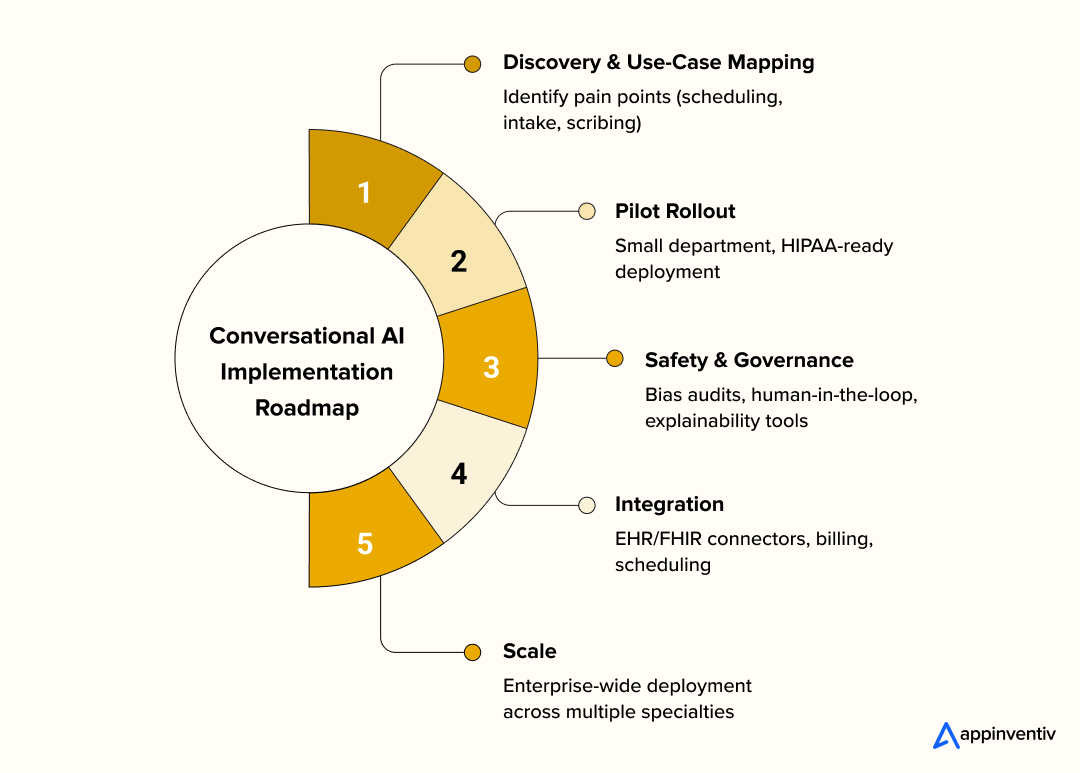
Future Outlook: Generative Conversational AI in Healthcare
We’re moving into a stage where chatbots that just answer questions won’t be enough. This shift shows the growing role of conversational AI for healthcare, where assistants can go beyond simple Q&As to handle full patient journeys. The next generation of tools will look more like AI virtual assistants that can think and act.
Instead of stopping at “here’s your appointment time,” they’ll capture a patient’s history, suggest the right next step, check coverage, and even trigger parts of the workflow in the background. It’s the difference between a clerk at the front desk and a real partner who can follow a patient through the entire journey.
McKinsey points out that the early wins will likely remain in the back office — things like scheduling, billing, and documentation — simply because the stakes are lower there. But over time, as governance and trust get stronger, more clinical use cases will emerge too, from symptom analysis to chronic disease management.
One area that’s already taking shape is voice-based AI. Research in npj Digital Medicine describes how voice agents can hold natural conversations, check symptoms daily for chronic patients, and even escalate cases when needed. This feels much closer to the way people actually interact with doctors — talking rather than typing.
And it won’t stop at voice or text. The future is clearly multimodal. That means systems pulling together text, audio, images, even data from wearables or home monitoring devices, and responding in real time. As healthcare conversational AI evolves, these multimodal AI systems will play a key role in making care more personalized and continuous. A scoping review on multimodal generative AI in healthcare shows promise in areas like diagnostics and medical reporting, though integration and validation are still hurdles.
Ultimately, the future of conversational AI in healthcare and especially conversational AI for hospitals will be defined by its ability to balance innovation with trust, compliance, and meaningful patient outcomes.
What It Will Take to Get There
For all the excitement, this future isn’t automatic. It depends on a few big things falling into place. Strong AI governance is one: with AI pulling in so much personal data, privacy and fairness checks will need to be built in from day one. Integration is another: agents won’t be useful if they can’t talk to EHRs, lab systems, and billing platforms. And maybe the biggest piece is trust. Patients and clinicians need to believe these tools are accurate, safe, and genuinely helpful — not just another layer of tech to wrestle with.
The good news is, we’re seeing the pieces start to come together. Vendors are building better EHR connectors. Regulators are beginning to think about frameworks for generative and conversational AI. And early pilots are proving that, when rolled out carefully, these tools can really ease workloads and make care feel more responsive. The road ahead will be messy, but if the momentum continues, conversational AI could move from being a novelty to becoming a core part of healthcare delivery in the next few years.
How Appinventiv Can Help with Conversational AI in Healthcare
At Appinventiv, we’ve learned that AI development services in healthcare isn’t just about plugging in a chatbot and calling it innovation. It has to fit into the messy, high-stakes reality of hospitals and clinics. That means starting with trust. If patients think their data isn’t safe, they won’t use it. If staff feel it adds one more system to wrestle with, they’ll ignore it. So we build with compliance at the core — HIPAA, GDPR, and whatever local rules apply — and we design these tools to sit inside the systems hospitals already live in, like EHRs and scheduling platforms, not float on the side as an extra app.
The other piece, maybe the most important one, is empathy. Conversational AI in Healthcare isn’t like checking your bank balance. Interaction with AI can be emotional, sometimes urgent, often personal. That’s why design matters. A good example is YouCOMM, a platform we built that lets hospital patients call for help using simple voice commands or gestures. Nurses get alerts instantly, patients feel heard, and the whole environment runs more smoothly. It’s not flashy tech for the sake of it — it’s a tool that makes people’s lives a little easier at a moment when they need it most.
Over time we’ve seen conversational AI do small but meaningful things: fewer missed appointments, faster responses, less paperwork on a nurse’s desk, and patients saying the system “just worked.” That’s the impact we care about with our healthcare software development services making the healthcare experience feel more human while taking some pressure off the people delivering care. Whether it’s a large hospital network trying to streamline operations or a young health-tech startup aiming to create something new, our role stays the same: build solutions that are secure, empathetic, and designed to last in the real world.
Ready to make patient communication simpler and safer? Let’s talk about building conversational AI that works in real hospitals.
FAQ’s
Q. What is conversational AI? And why does it matter in healthcare?
A. At its core, conversational AI is software that can actually “talk back.” It understands natural language, responds in real time, and learns from the way people interact with it. In healthcare, this matters because patients don’t speak in checkboxes — they explain symptoms, ask anxious questions, and want clear answers. A chatbot with canned scripts won’t cut it. Conversational AI helps fill that gap by making digital interactions feel more like real conversations, while taking routine load off already stretched staff.
Q. How conversational AI is used in healthcare today?
A. Most people experience it without even realizing. Appointment reminders that you can confirm by text? That’s conversational AI. Chat assistants on hospital websites answering insurance questions or helping patients find the right department? Also conversational AI. On the provider side, it’s helping doctors by transcribing visits, drafting notes, and capturing intake information before a patient ever sets foot in the exam room. Some hospitals are even piloting daily check-ins with chronic care patients — a quick voice or text exchange that flags problems early instead of waiting for a crisis.
Q. What are the benefits of enterprise adoption of conversational AI in healthcare?
A. When a large health system adopts conversational AI, the gains show up in multiple ways. Call wait times shrink, scheduling becomes smoother, and patients stop missing as many appointments. Clinicians notice it too — less repetitive admin work and more time for actual patient care. For enterprises, it also means a more unified digital front door. Whether a patient is booking online, using a voice assistant, or following up after discharge, the experience feels consistent and a lot less frustrating.
Q. Which type of AI is currently being used in the healthcare industry?
A. Different types of AI are running in parallel across the industry. Predictive models are flagging patients at higher risk, machine learning is reading scans and lab reports, and generative AI is starting to draft clinical notes and support drug discovery. Conversational AI is the one people interact with directly — the voice bot at the hospital, the symptom checker in a mobile app, the assistant that answers late-night questions about medication. It’s the “face” of AI in healthcare because it touches everyday communication.
Q. What challenges come with enterprise adoption of conversational AI in healthcare?
A. It’s not all smooth. Data privacy is a constant worry — one breach and patient trust is gone. Integration is another headache: most hospitals already juggle multiple IT systems, and if conversational AI can’t talk to EHRs or billing platforms, it ends up as another disconnected tool. Adoption also takes effort. Staff may fear it’s replacing them, and patients may hesitate to trust an AI with personal questions. The hospitals that succeed usually roll it out step by step, make security and compliance crystal clear, and show staff how it lightens their workload instead of adding to it.
Q. What does the future of conversational AI in healthcare look like?
A. We’re heading toward AI that doesn’t just chat — it can listen, see, and act. Think multimodal systems that combine voice, text, and data from wearables to give patients real-time support. Instead of just confirming an appointment, an AI assistant could capture your medical history, check insurance coverage, flag potential risks, and book follow-ups in one flow. Reports from firms like McKinsey and Deloitte suggest hospitals will keep starting with admin-heavy tasks, but as trust grows, conversational AI will move deeper into clinical workflows. The long-term goal? A healthcare system where access feels immediate and continuous, not limited to office hours.


- In just 2 mins you will get a response
- Your idea is 100% protected by our Non Disclosure Agreement.
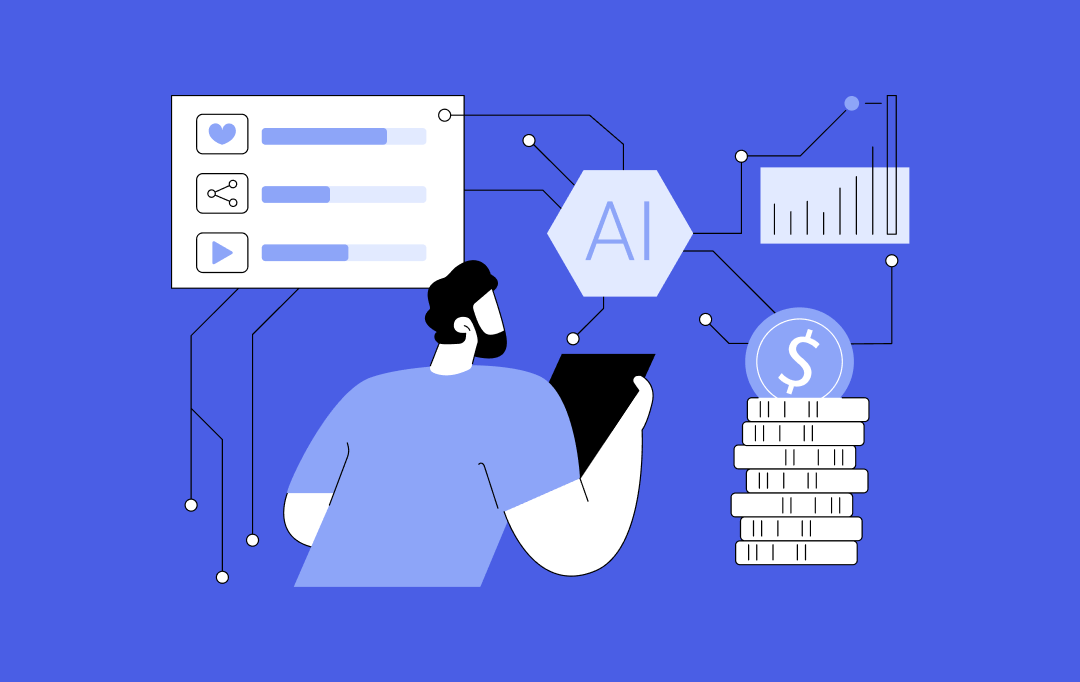
How AI Tokenization is Enabling Secure and Transparent Asset Ownership in 2026
By 2026, AI tokenization has moved beyond early-stage experiments and pilot projects. Tokenizing real-world assets has become a serious commercial strategy for financial institutions, supply chain operators and technology-driven enterprises. A 2025 report by the World Economic Forum in collaboration with Accenture highlights tokenization as a key mechanism for value exchange in modern financial markets.…

13 Ways Generative AI is Transforming the Hospitality Industry
Key takeaways: The most mature applications of Generative AI for hospitality are in guest service, revenue management, marketing, and operations automation. Real value comes from integrating generative AI into hospitality operations and existing PMS, CRS, CRM, and POS systems, rather than using stand-alone tools. Successful programs treat Generative AI in hospitality as a product, incorporating…
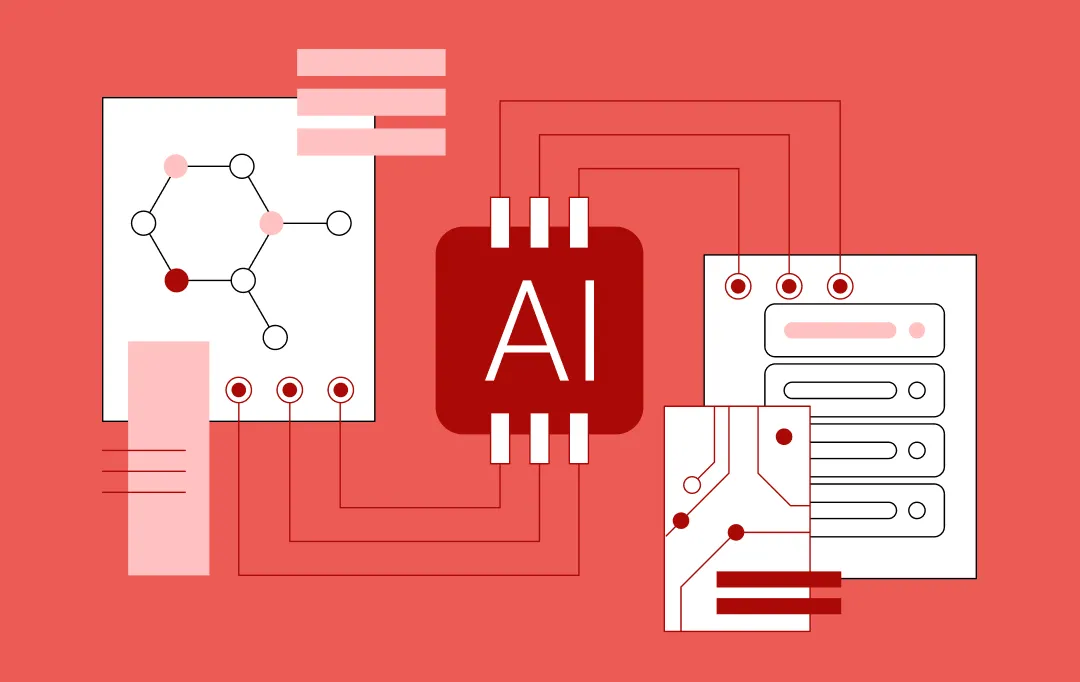
Scaling AI Initiatives: Why MLOps Matters More Than DevOps
Key takeaways: DevOps runs systems. MLOps keeps decisions accurate. MLOps vs DevOps is a leadership choice, not a technical one. Scaling AI without MLOps only scales risk. MLOps turns AI into infrastructure, not experiments. Operational maturity beats model sophistication. Real advantage comes from mastering DevOps and machine learning together. Most leadership teams don’t fail at…











